Related Research Articles

The province of Grosseto is a province in the Tuscany region of Italy. Its capital is the city of Grosseto. As of 2013 the province had a total population of 225,098 people.
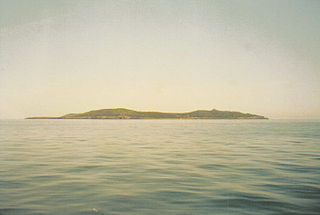
Giannutri is a small island in the Tyrrhenian Sea off the coast of Tuscany, Italy; it is the southernmost island of the Tuscan Archipelago and it is a frazione of the comune of Isola del Giglio in the Province of Grosseto.

Isola del Giglio, or Giglio Island in English, is an Italian island and comune (municipality) in the Tyrrhenian Sea, off the coast of Tuscany, and is part of the Province of Grosseto. The island is one of seven that form the Tuscan Archipelago, lying within the Arcipelago Toscano National Park. Giglio means "lily" in Italian, and though the name would appear consistent with the insignia of Medici Florence, it originally derives from the Latin name of the island, Igilium, which in turn could be related to the Ancient Greek name of the neighbouring Capraia, Αἰγύλιον, from αἴξ aíx "goat".

The Tuscan Archipelago is a chain of islands between the Ligurian Sea and Tyrrhenian Sea, west of Tuscany, Italy.

Capraia is an Italian island, the northwesternmost of the seven islands of the Tuscan Archipelago, and the third largest after Elba and Giglio.

Porto Santo Stefano is a seaport town on the west coast of Italy, in the municipality of Monte Argentario, in the Province of Grosseto, Tuscany. It is the municipal seat of Monte Argentario and one of the two major towns that form the township, along with Porto Ercole. The region is on the slopes of Mount Argentario, which dominates the whole area. Porto Santo Stefano is 150 kilometres northwest of Rome.

Giglio Porto is a village in Tuscany, central Italy, administratively a frazione of the comune of Isola del Giglio, province of Grosseto. As of 2021, its population amounted to 750.
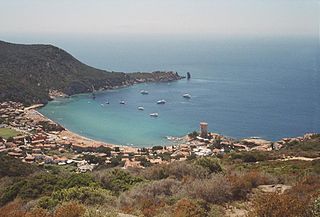
Giglio Campese is a village in Tuscany, central Italy, administratively a frazione of the comune of Isola del Giglio, province of Grosseto. At the time of the 2001 census its population amounted to 154.

Portoferraio lighthouse, called Faro del Forte Stella Lighthouse since is placed on the northern rampart of Forte Stella built in 1548 by Cosimo I de' Medici in Portoferraio, Elba.
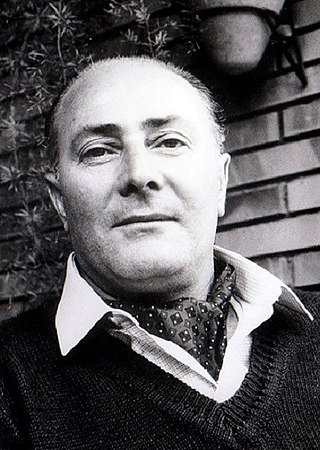
Raffaello Brignetti was an Italian writer. He grew up on the island of Elba where his father was a lighthouse keeper. He moved to Rome in the middle of the Second World War, and spent a couple of years in German labour camps. He studied modern Italian literature at university, graduating in 1947. He was a disciple of Ungaretti, in common with other young idealistic intellectuals of his era such as Leone Piccioni, Silori Luigi, Mario Petrucciani, Elio Filippo Accrocca, etc.
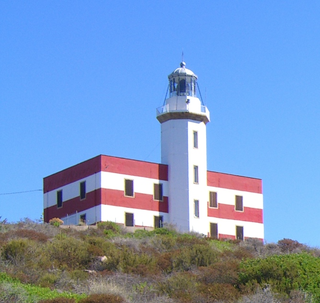
Punta di Capel Rosso lighthouse or Punta Rossa is an active lighthouse on Isola del Giglio on the Tyrrhenian Sea.

Pianosa Lighthouse is an active lighthouse located on the east side of Pianosa Island.

Ventotene Lighthouse is an active lighthouse on the Ventotene Island placed nearby the Porto Romano.
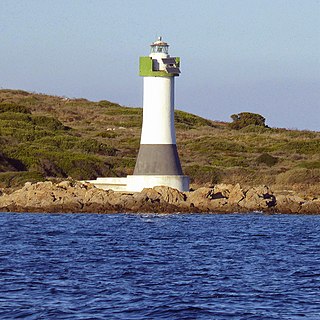
Isola delle Bisce Lighthouse is an active lighthouse located on a small islet, 590 metres (1,940 ft) from Capo Ferro Lighthouse, which make part of the Maddalena archipelago in the Strait of Bonifacio. The lighthouse guides the ships through the narrow Canale delle Bisce; the structure is situated in the municipality of Arzachena on the Tyrrhenian Sea.

Isola della Bocca Lighthouse is an active lighthouse located on a small islet, at the southern entrance of the outer Port of Olbia, 250 metres (820 ft) from the mainland, in the municipality of Olbia on the Tyrrhenian Sea.

Isola Razzoli Lighthouse is an active lighthouse located on an islet, 2.45 kilometres (1.52 mi) long, in the Maddalena archipelago. The lighthouse is the northernmost in Sardinia, on the eastern approach to the Strait of Bonifacio, and is at 7.42 kilometres (4.61 mi) from the French Lavezzi archipelago. The island is in the municipality of La Maddalena on the Tyrrhenian Sea.

Punta Filetto Lighthouse is an active lighthouse located on the Isola Santa Maria, which makes part of the Maddalena archipelago, on the northern point of the island facing Barrettinelli di Fuori Lighthouse from which it is 1.4 kilometres (0.87 mi) away. The island is in the municipality of La Maddalena on the Tyrrhenian Sea.

Gherardo Felloni is an Italian fashion designer, currently the creative director of the House of Roger Vivier.
Roger Vivier is a French fashion accessories label founded by Roger Vivier in 1937 that specializes in shoes. In the early 1950s, the brand's namesake designer produced the first modern stiletto heel. Another signature design associated with the brand is the Belle Vivier, an elegant pump with a large chrome-plated buckle. The pump made its debut at the Yves Saint Laurent's fashion show in 1965 and it became one of the most in-demand styles of the decade. In 1967, the shoes were forever immortalized in Luis Buñel’s film Belle de Jour when Catherine Deneuve wore them.
References
- 1 2 Nelli 2018, p. 77, Micro-eolico nel faro delle Vaccarecce al Giglio.
- ↑ "Isola del Giglio". Blog Maremma.it. 2023-01-24. Retrieved 2024-02-14.
- ↑ "History". 2022-02-04. Retrieved 2024-02-14.
- ↑ Pithers, Ellie (2021-03-24). "A Glamorous High-Heeled Shoe, Crafted From Newsprint". The New York Times. ISSN 0362-4331 . Retrieved 2024-02-14.
- ↑ Smallwood, Nicole (2020-05-05). "My Style: Gherardo Felloni". Country and Town House. Retrieved 2024-02-15.
- ↑ michelefossi (2022-02-21). "A lighthouse with a view. Interview with designer Gherardo Felloni". Michele Fossi. Retrieved 2024-02-15.
- ↑ Hirschmiller, Stephanie (2020-07-08). "Roger Vivier's Creative Director Gherardo Felloni on Spending Lockdown in a Lighthouse + His Post-Pandemic Strategy". Footwear News. Retrieved 2024-02-15.
- ↑ "Fleurs de Villes Journal - The Gardens Inspiring Roger Vivier". www.fleursdevilles.com. Retrieved 2024-02-15.